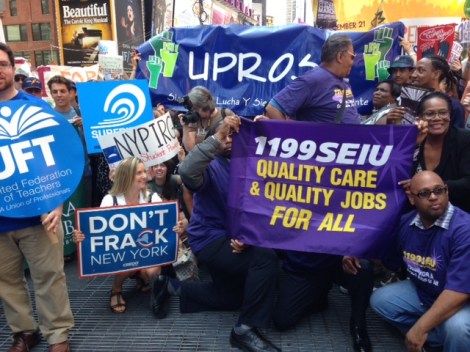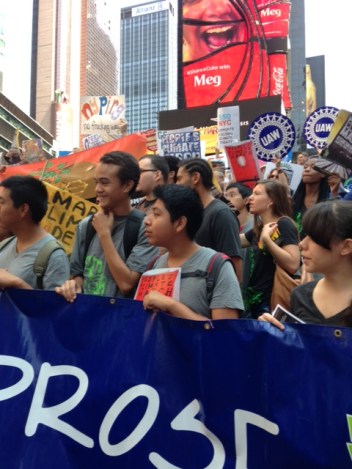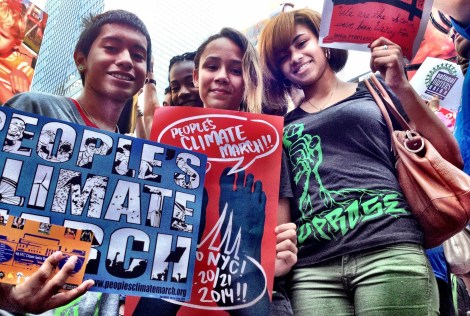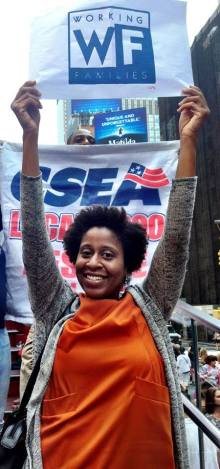More than 500 organizations are planning a historic event for Sept. 21 in New York City, what they say will be the largest rally for climate action ever. Organizers and ralliers will be calling on world leaders to craft a new international climate treaty, two days before those leaders will convene at a Climate Summit at the United Nations headquarters. Jamie Henn, spokesperson for 350.org, the main convener of the event, declined to offer a precise target for turnout, but the current holder of the largest-climate-rally title, a February 2012 march on the White House, drew around 50,000 people, so organizers are expecting more than that — possibly significantly more.
However many people show up, though, this march will likely be historic for another reason: its diversity and its focus on climate justice. More than 20 labor unions are among the organizations leading in the planning and turnout efforts. On Wednesday morning, representatives of a handful of them gathered in the Midtown Manhattan office of 1199, the local chapter of the Service Employees International Union (SEIU), for a press conference, and then they were joined in Times Square by more unions for a small pep rally to promote the September event. Other groups present included locals from the International Brotherhood of Electrical Workers, the Transport Workers Union of Greater New York (TWU), and local social- and environmental-justice organizations such as UPROSE and the NYC Environmental Justice Alliance.
These locals are larger than they sound. 1199 and 32BJ, another union also affiliated with SEIU, cover multiple large East Coast states including New York, Massachusetts, and Florida. 1199 alone has more than 400,000 members. And they are diverse — 1199 represents healthcare workers such as nurses, and 32BJ represents custodial workers. These are not like the overwhelmingly white male unions in the construction trades. They are predominantly non-white and largely made up of women. This includes their top leadership, and their representatives at Wednesday’s event.
Speakers at the press conference and the rally focused on the ways low- and middle-income New Yorkers like their members are affected by climate change. Hurricane Sandy loomed large. In the storm’s aftermath, hospital and transportation workers were tasked with trying to save lives and get the city running amid flooded infrastructure and prolonged blackouts. For people who care about being able to provide reliable transportation and healthcare, the threat of more frequent superstorms, heat waves, and floods is alarming. And the flooding of waterfront industrial districts like the South Bronx and Brooklyn’s Sunset Park caused major disruption for private sector blue-collar workers and nearby working class neighborhoods.
Many of the union members live in public housing, which is often located in waterfront neighborhoods like the Lower East Side, Red Hook, and Far Rockaway. Those low-lying projects were among the worst-hit areas during Sandy. “Twenty percent of public housing in New York City was affected by Sandy,” said Eddie Bautista, executive director of the NYC Environmental Justice Alliance. “It’s about community health, it’s about jobs, and it’s about justice.”
The unions also see moving to a sustainable clean energy economy, instead of one based on extracting fossil fuels, as a matter of economic self-interest. 1199, unlike some construction unions, opposes approval of the Keystone XL oil pipeline because, says spokesperson Chelsea-Lyn Rudder, “We want long-term jobs, not the short-term jobs that Keystone might create.” Cutting down on auto emissions and oil consumption by expanding mass transit, instead of building an oil pipeline, would create permanent jobs driving buses and trains. “Mass transit is green jobs,” noted LaTonya Crisp-Sauray, an official from the TWU.
The concerns for these communities go beyond extreme weather events like Sandy. A custodian from the Bronx who gave her name only as Mary, and was there on behalf of 32BJ, pointed out that asthma could be worsened by climate change, and it is already an epidemic in heavily polluted, lower-income communities like the Bronx. “The Bronx has a 20 percent childhood asthma rate, one of the highest rates in the nation,” she said. “[Combatting climate change] is about saving lives.”

At the little pep rally in Times Square, the group of about 100 was filled with union members sporting their locals’ T-shirts and waving their banners. Even the United Auto Workers had a few members present. And the social-justice groups brought out everyone from older women to teenagers.
The result was a remarkable sight. Here was a rally for addressing climate change — an issue so often dismissed by conservatives as of interest only to out-of-touch affluent elites like Hollywood actors and former vice presidents — where both the speakers and the crowd were mostly black and Latino. These were members of the most affected communities — including Roberto Borrero from the International Indian Treaty Council, which works for indigenous rights throughout the Americas — talking about how the issue affects them.
 The environmental movement is often criticized for being mostly white, male, wealthy, and college-educated. As Grist’s Brentin Mock just noted, it is the leaders of environmental organizations who come from that demographic, even though the neighborhoods with the worst pollution are disproportionately low-income and non-white. Sure enough, some of the only white male speakers at Wednesday’s event were the ones from environmental organizations. But at least they recognize the importance of communities of color and blue-collar workers in the movement, and they have successfully partnered with civil-rights, social-justice, and labor organizations.
The environmental movement is often criticized for being mostly white, male, wealthy, and college-educated. As Grist’s Brentin Mock just noted, it is the leaders of environmental organizations who come from that demographic, even though the neighborhoods with the worst pollution are disproportionately low-income and non-white. Sure enough, some of the only white male speakers at Wednesday’s event were the ones from environmental organizations. But at least they recognize the importance of communities of color and blue-collar workers in the movement, and they have successfully partnered with civil-rights, social-justice, and labor organizations.
The images from the march on Sept. 21 probably won’t conform to the snarky stereotypes about Vermont liberals wearing Birkenstocks and driving Volvos. Of course, inconvenient truths have never stopped conservatives from casting unfair aspersions. But even if those conservatives won’t admit it, the movement is diversifying.





